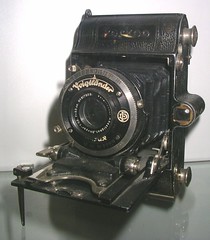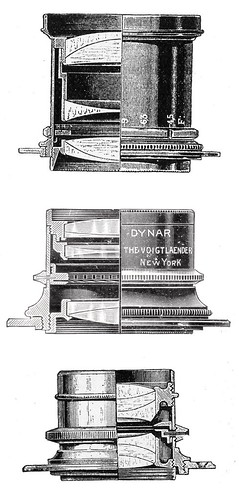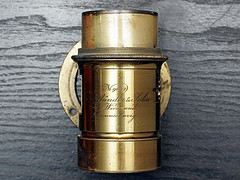Voigtländer

|
| Voigtländer Perkeo with Skopar lens |
Voigtländer is one of the the world's oldest companies for optical instruments.
Contents
Chronology

|
| Petzval lens |
- Founded by Johann Christoph Voigtländer in the year 1756 in Vienna (Austria), it was the first factory for optical instruments and precision mechanics there.
- In 1763 the company got protection by a decree from Austria's Empress Maria Theresia.
- In 1797 the state allowed Voigtländer to produce measuring instruments.
- In 1823 they got a royal privilege to produce opera binoculars.
- In 1840, shortly after the invention of photography had been published by its inventors Daguerre and Fox Talbot, Voigtländer produced the first camera lens which had been developed on the base of analytical calculations. This was an early landmark on the way to practical usage of photography. These Petzval portrait lenses had been designed and calculated by the mathematician Professor Jozef Maximilián Petzval and further developed by the company founder's grandson Peter Wilhelm Friedrich von Voigtländer. The exposure times had been reduced dramatically by using the new 149mm lenses which allowed an aperture up to 1:3.7 .
- In the following year 1841 Voigtländer introduced cameras made of metal.
- In 1862 Voigtländer had produced its 10,000th camera lens.
- In 1868 the Voigtländer headquarters moved from Austria's capital Vienna to Braunschweig in Germany.
- In 1898 Voigtländer became a stock market company.
- In 1900 the "Reise Kamera" (travel camera) was introduced.

|
| a Voigtländer Voigtar lens in a Voigtländer shutter |
- In 1931 Voigtländer entered the mass market with the BESSA camera for 6x9 format.
- In 1939 the VITO, their first camera for 35mm film, was well received by the customers.
- In 1955 the 4,000,000th lens had been produced.
- In 1959 they introduced the Zoomar, the world's first interchangeable zoom lens.
- In 1970 Voigtländer was merged with Zeiss-Ikon.
- In 1974 Voigtländer became part of Rollei .
- 1980 Plusfoto became Voigtländer's sales organisation.
- Since 1987 Ricoh and Chinon make cameras for Voigtländer.
- In 1994 the last part of the original Voigtländer company in Braunschweig was closed.
- In 1995 Ringfoto bought Plusfoto and the Voigtländer brand.
- In 1999 the popular 35mm viewfinder camera body Bessa L was introduced, developed and produced by Cosina
Voigtländer camera lenses

|
| Lenses: Heliar, Dynar and Kollinear |
Despite of the successful early metal camera designed by Voigtländer lenses were the company's main contribution to early photography in the 19th century. And the success of Voigtländer's camera lines of the 20th century was based on the quality of its lenses. At the turn from the one to the other century Voigtländer had a branch office in New York, Voigtlander & Son Optical Co. . It advertised Voigtländer lenses like the Dynar for usage with the better Kodak cameras.
The beginning was made with the Petzval lens which became a timeless standard lens for portrait photography. It is Voigtländer's great lens design of the company's days in Austria. Many cameras of renowned or unknown makers were equipped with Voigtländer lenses, mainly with the fast Petzval lens since portrait cameras were the butter-and-bread tools of the photographers. The lens had four elements, divided in two groups. The two front elements were glued together, the two back elements just placed close to each other. The lens had a characteristic vignetting and curvature of field, but it made images which were very sharp in the centre.
At the turn to the 20th century Voigtländer switched to another fast lens design, the Heliar, a symmetric lens invented by Carl August Hans Harting in 1900, improved by him as asymmetric lens in 1902. Other fine lens designs of that time were the Dynar and Kollinear lenses.
During the 20th century the Skopar and Color Skopar lenses became the standard lenses for Voigtländer's own cameras.
A milestone in camera lens making was the Zoomar, the world's first interchangeable zoom lens.

|

|
| No. 9643 |
Lenses
- Petzval portrait lens
- Dynar, Tele-Dynar
- Heliar
- Radiar
- Voigtar
- Skopar
- Color Skopar
- Zoomar
- Skoparon
- Dynaron
- Lanthar, Apo-Lanthar
Voigtländer cameras
early cameras
- 1840: Daguerreotyp-Apparat zum Portraitiren
- 1890: Reisekamera
- 1900: Reisekamera Typ A
- Reisekamera Tropical
35mm SLR
35mm rangefinder, interchangeable lens
35mm folding
35mm fixed lens
- Vito B, small or big finder
- Vito BL
- Vito BR
- Vitomatic I
- Vitomatic II
- Vitomatic Ia
- Vitomatic IIa
- Vitomatic Ib
- Vitomatic IIb
- Vitomatic IIIb
- Vitomatic ICS
- Vitomatic IICS
- Vitomatic IIICS
- Vito C
- Vito CD
- Vito CL
- Vito CLR
- Vito CS
- Vito CSR
- Vito Automatic
- Vito Automatic I
- Vito Automatic II
- Vito Automatic R
- Dynamatic
- Dynamatic II
- Vitoret
- Vitoret F
- Vitoret R
- Vitoret L / LR
- Vitoret D / DR
- Vitoret Rapid D
- Vitrona
120 folding
- Inos I (6×9)
- Inos II (6×9)
- Virtus (6×6)
- Prominent (6×9)
- Bessa (prewar) (6×9)
- Bessa RF (6×9)
- Bessa I (6×9)
- Bessa II (6×9)
- Bessa 46 (4.5×6)
- Bessa 66 (6×6)
- Perkeo I (6×6)
- Perkeo II (6×6)
- Perkeo E (6×6)
- Rollfilmkamera (6×9)
120 TLR
- Brillant
- Superb
127 folding
- Perkeo (3×4)
Folding plate cameras
reflex cameras
- 1905: Heliar Reflex ( 9 x 12 )
- 1908: Bijou
- 1912: Spiegel-Reflex-Kamera
stereo cameras
- 1902: Stereoskop
- 1905: Stereo and Panorama Kamera ( 9 x 14 )
- 1907: Stereophotoskop ( 4,5 x 10,7 )
- 1911: Alpin Stereo ( 10 x 15 )
- 1912: Spiegelreflex-Stereo
- 1913: Stereflektoskop ( 6 x 13 )
Zeiss Ikon / Voigtländer
35mm SLR
For the Icarex line, see Zeiss Ikon.
35mm fixed lens
- Vitessa 500 L / 500 S / 500 AE electronic / 500 SE electronic / 1000 SR
126 film viewfinder
- Bessy k/ak/as/s
- Vitessa 126 CS / 126 electronic / 126 S electronic
Voigtländer (Rollei)
35mm SLR
With 42mm screw lenses:
- VSL 1 (TM)
- VSL 2CX automatic (prototypes)
With Rolleiflex SL35 lenses:
- VSL 1 (BM)
- VSL 2 automatic
- VSL 3-E
- Vitoflex E (prototypes)
35mm rangefinder
- VF 101 (1974–76)
- VF 102 (1974, prototype)
- VF 135 (1976–80)
- VF 35F (1981)
- XF 35 (1981)
Intermediate period
35mm
- Vito
- Vito C
- Vito CS
- Vito C-AF
110 film pocket camera
- Vitoret 110 (1976–81)
- Vitoret 110 EL (1976–81)
Later products with the Voigtländer brand
Long after the demise of the original Voigtländer company, the brand was re-used by Ringfoto and Cosina.
Links
- Voigtländer
- An Article on the Heliar Lens
- Voigtländer site by Dietrich Drescher, alias doppeld
- Voigtländer page by Frank Mechelhoff
- Schoebels' Voigtländer archive
- Voigtländer Verein Club
- Some 40 Voigtlander instruction manuals in English, scanned in PDF format, 600 dpi
- Voigtländers on ukcameras
- Voigtländer illustrated history
- Large Voigtländer section at Retrography.com by Simon Simonsen, Denmark
- Voigtländer Cameras Price Guide at CollectiBlend
- Voigtlander instruction manuals - English at Orphancameras.com
- Voigtländer Camera Manuals : Photo-Manuals.com by Ben Squire
In French :
- Cameras and user manuals at www.collection-appareils.com
- Voigtlander page at Collection G. Even's site





